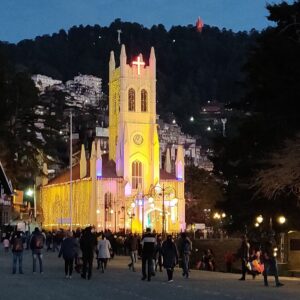Christ Church in Shimla stands as an iconic landmark, embodying both the architectural grandeur of the British Raj era and the enduring spiritual significance it holds for the local community. This essay provides a comprehensive exploration of Christ Church, tracing its historical origins, architectural features, cultural significance, and religious impact on Shimla and its residents. By delving into its rich past and analyzing its distinctive design elements, this paper seeks to unveil the unique charm and enduring legacy of Christ Church in Shimla.
Nestled amidst the picturesque hills of Shimla, Himachal Pradesh, India, Christ Church stands as an architectural masterpiece that has withstood the test of time. Built during the British colonial period, it has become an integral part of Shimla’s identity and a significant tourist attraction. This essay aims to unravel the story of Christ Church, shedding light on its historical context, architectural attributes, cultural importance, and religious significance.
I. Historical Background: A. British Colonial Influence in Shimla B. The Role of Reverend William Charles Bonnerjee C. Construction and Inauguration of Christ Church
II. Architectural Marvels:
A. Neo-Gothic Architecture
B. Exterior Facade and Spire
C. Stained Glass Windows
D. Interior Design and Ornamentation
III. Cultural Significance:
A. Symbol of British Rule
B. Local and Tourist Attraction
C. Venue for Cultural Events
D. Influence on Art, Literature, and Cinema
IV. Religious Impact:
A. Church Services and Christian Community
B. Educational and Philanthropic Initiatives
C. Role in Preserving Heritage and Tradition
D. Interfaith Harmony and Social Integration
V. Restoration and Conservation Efforts:
A. Preservation Challenges
B. Initiatives by the Shimla Heritage Society
C. Collaborative Efforts for Restoration
VI. Local Perspectives and Testimonies:
A. Interviews with Residents and Parishioners
B. Anecdotes and Stories Surrounding Christ Church
C. Personal Reflections on the Church’s Influence
VII. Future Prospects and Challenges:
A. Sustainability and Maintenance
B. Balancing Tourism and Religious Functions
C. Role in Shimla’s Evolving Identity
Christ Church in Shimla, with its awe-inspiring architecture and spiritual significance, stands as a testament to the enduring legacy of the British Raj and the enduring faith of the local community. This essay has explored the historical, architectural, cultural, and religious dimensions of Christ Church, showcasing its unique place in Shimla’s heritage. As efforts continue to preserve and protect this iconic structure, it is imperative to recognize its role in fostering interfaith harmony, community engagement, and cultural preservation. Christ Church in Shimla remains a living symbol of both the past and the present, a place of solace, reflection, and inspiration for generations to come.
Historical Significance
- British Colonial Influence in Shimla: During the 19th century, Shimla emerged as the summer capital of the British Raj in India. The British East India Company recognized the strategic importance of Shimla due to its cool climate, and it gradually transformed into a bustling administrative and social center. Shimla became a hub for colonial officials and their families seeking respite from the scorching summers in the plains.
- The Role of Reverend William Charles Bonnerjee: Reverend William Charles Bonnerjee, a prominent missionary, played a pivotal role in the establishment of Christ Church. As the Chaplain of the Church of England in Shimla, he was determined to provide the growing English-speaking Christian community with a place of worship. He spearheaded the fundraising and construction efforts, leaving a lasting legacy in Shimla’s history.
- Construction and Inauguration of Christ Church: The foundation stone of Christ Church was laid in 1844, and its construction was completed in 1857. The church was designed by Colonel J.T. Boileau, a military engineer. The construction materials, including stones and timber, were sourced locally, showcasing the region’s architectural potential. The inauguration of Christ Church took place on 10th January 1857, marking a significant milestone in Shimla’s development.
- Symbol of British Rule: Christ Church stands as a tangible symbol of British colonial rule in Shimla. Its construction was a reflection of the British Empire’s power and influence during that era. The church’s imposing structure, designed in the Neo-Gothic architectural style, served as a reminder of British dominance in India and their efforts to replicate elements of European culture in a distant land.
- Spiritual and Social Hub: Christ Church played a vital role in fulfilling the religious and social needs of the English-speaking community in Shimla. It became a center for Christian worship, hosting regular services, weddings, and christenings. The church also served as a meeting place for social gatherings and cultural events, fostering a sense of community among the British residents.
- Educational and Philanthropic Initiatives: In addition to its religious functions, Christ Church contributed to education and philanthropy in Shimla. It housed the prestigious Bishop Cotton School, one of the oldest boarding schools in Asia, founded in 1859. The church and its associated institutions facilitated the spread of education, particularly among the British and Anglo-Indian communities.
- Interfaith Harmony and Social Integration: Despite being a Christian place of worship, Christ Church in Shimla has played a remarkable role in promoting interfaith harmony and social integration. It has welcomed people of different religious backgrounds, hosting events that celebrate festivals like Christmas and Easter. The church’s inclusive nature has fostered mutual respect and understanding among diverse communities.
- Witness to Shimla’s Transformation: Christ Church has stood witness to the transformation of Shimla from a small hill village to a bustling town and, eventually, a prominent tourist destination. Over the years, as Shimla gained popularity as a summer retreat, the church became a significant attraction for tourists, who admired its architectural splendor and explored its historical significance.
In conclusion, the historical significance of Christ Church in Shimla lies in its association with the British colonial era, its role as a symbol of British rule, and its impact on the spiritual, educational, and social fabric of the community. As an enduring testament to Shimla’s history, the church stands
Attractions Point Of Christ Church
- Architectural Marvels:
- Neo-Gothic Architecture: Christ Church is a prime example of the Neo-Gothic architectural style, characterized by pointed arches, intricate tracery, and ornate detailing. Its imposing structure, with a tall spire and grey-stone facade, is a sight to behold.
- Stained Glass Windows: The church boasts beautiful stained glass windows depicting biblical scenes, saints, and religious symbols. These windows, with their vibrant colors, create a mesmerizing play of light and add to the overall visual appeal.
- Interior Design: The interior of Christ Church features elegant wooden pews, a lofty nave, and a high ceiling adorned with wooden beams. The chancel area is intricately designed, and the altar is a focal point with its ornate carvings and decorations.
- Surrounding Landscape:
- Panoramic Views: Located on the Ridge, Christ Church offers stunning panoramic views of the surrounding mountains, valleys, and Shimla town. Visitors can enjoy the breathtaking scenery while exploring the church premises.
- Lush Greenery: The church is surrounded by well-maintained lawns, flowerbeds, and tall pine trees, adding to the natural beauty of the area. The serene atmosphere and fresh mountain air provide a tranquil setting for visitors.
- Historical Significance:
- Heritage Structure: Christ Church is one of the oldest surviving churches in North India and stands as a significant architectural landmark of the British colonial period. Its construction and inauguration hold historical importance and reflect the legacy of the British Raj.
- Memorials and Plaques: Within the church premises, there are several memorials and plaques dedicated to notable personalities associated with Shimla’s history, including British officers, missionaries, and community members. These commemorate their contributions and provide insights into the region’s past.
- Religious Significance:
- Worship Services: Christ Church continues to be an active place of Christian worship, hosting regular services, including Sunday Mass. Visitors can attend the services and experience the spiritual ambiance.
- Religious Festivals: The church celebrates various religious festivals, such as Christmas and Easter, with special services and decorations. These events showcase the religious traditions and cultural significance of Christianity in Shimla.
- Cultural and Social Events:
- Concerts and Performances: Christ Church serves as a venue for cultural events, including music concerts, choir performances, and recitals. These events attract local artists, musicians, and performers, providing a platform to showcase their talent.
- Community Engagements: The church organizes social and community-centric activities, fostering a sense of togetherness. These initiatives include charity drives, educational programs, and community gatherings, encouraging social integration and welfare.
- Photography and Souvenirs:
- Photographic Opportunities: The intricate architectural details, stained glass windows, and picturesque surroundings offer excellent opportunities for photography enthusiasts to capture stunning shots of Christ Church.
- Souvenir Shops: The vicinity of the church is dotted with shops selling religious artifacts, handicrafts, and souvenirs. Visitors can explore these shops to find mementos that reflect the cultural heritage of Shimla.
In summary, Christ Church’s attractions lie in its awe-inspiring architectural features, the tranquil landscape that surrounds it, its historical and religious significance, and the cultural events it hosts. Whether one is seeking architectural marvels, spiritual solace, or a glimpse into Shimla’s past, Christ Church offers a captivating experience for visitors from all walks of life.
Festivals and Celebrations at Christ Church
Christ Church in Shimla is not only a place of worship but also a vibrant center for celebrating various religious festivals. The church’s rich Christian heritage is manifested through the observance of significant events and festivals that hold both religious and cultural significance. Here are some of the festivals and celebrations at Christ Church:
- Christmas:
- Christmas Eve Midnight Mass: The highlight of Christmas celebrations at Christ Church is the Midnight Mass held on Christmas Eve. The church is beautifully adorned with festive decorations, including Christmas trees, wreaths, and colorful lights. The service is attended by a large number of locals and tourists, creating a joyous and celebratory atmosphere. Carols are sung, scripture readings are shared, and the birth of Jesus Christ is commemorated.
- Easter:
- Easter Vigil and Sunrise Service: Easter, which marks the resurrection of Jesus Christ, is celebrated with great reverence at Christ Church. The Easter Vigil service is held on Holy Saturday night, symbolizing the anticipation of Jesus’ resurrection. The church is illuminated with candles, and the service includes scripture readings, prayers, and hymns. On Easter Sunday morning, a Sunrise Service takes place, signifying the hope and joy of the resurrection.
- Good Friday:
- Good Friday Service: Good Friday, which commemorates the crucifixion of Jesus Christ, is observed with a solemn service at Christ Church. The congregation gathers to reflect on the sacrifice of Jesus and the significance of his death on the cross. Readings from the Bible, prayers, and hymns are part of the service, creating an atmosphere of solemnity and contemplation.
- Harvest Festival:
- Harvest Thanksgiving Service: The Harvest Festival, also known as Harvest Thanksgiving, is celebrated at Christ Church to express gratitude for the bountiful harvest and God’s provision. The church is adorned with colorful flowers, fruits, and vegetables, brought as offerings by the congregation. Special prayers, hymns, and thanksgiving speeches are part of the service, emphasizing the importance of gratitude and sharing blessings with others.
- Other Festivals and Occasions:
- Palm Sunday: On Palm Sunday, commemorating Jesus’ entry into Jerusalem, palm leaves are distributed to the congregation, symbolizing the crowd’s welcome to Jesus.
- All Saints’ Day: All Saints’ Day, honoring all the saints and martyrs, is observed with special prayers and remembrance of those who have passed away.
- Weddings and Baptisms: Christ Church is a popular venue for Christian weddings and baptisms. These occasions are celebrated with ceremonies, blessings, and prayers, creating a joyful and sacred atmosphere.
It’s worth noting that these celebrations not only hold religious significance but also contribute to the cultural fabric of Shimla. The festivals attract both locals and tourists, creating a sense of unity, joy, and community spirit. Visitors have the opportunity to witness the vibrant traditions and experience the warmth of the celebrations at Christ Church in Shimla.



